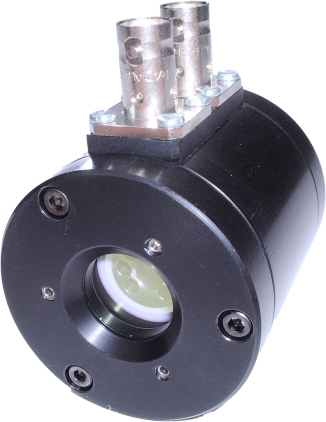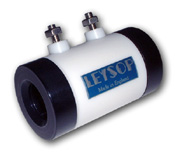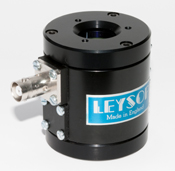Three-Electrode KD*P Pockels cells
For regenerative amplifiers and pulse slicing with avalanche drivers.

This useful type of Pockels cell is designed particularly for use in pulse slicing and pulse picking applications.
Using just one crystal of KD*P, it is essentially two Pockels cells, back to back, in one package (but without the join)!
The outer ring electrodes are arranged at the ends as usual in a longitudinal mode Pockels cell and are connected to the external drivers.
The centre electrode is held at the system Earth potential. The two Pockels cells are thus operated independently, one to turn on the Pockels cell, the other to turn it off.
The benefits of this arrangement over conventional 4 teminal device operation will be made clear below.
Obtaining long pulses with fast leading and falling edges is very difficult to achieve with any conventional single pulse generator. The better technique is to concentrate efforts on obtaining a fast leading edge and let the geometry of the Pockels cell take care of the falling edge. Two high voltage step generators then drive each of the halves of the Pockels cell independently, one providing the fast leading edge and the other the fast falling edge and great flexibility of selection of pulse length is obtained by adjusting the relative timings of the voltage steps.
For risetimes of a few ns or longer, FET pulsers provide adequate performance. However, as risetimes fall below a couple of ns or so, the ideal drive source becomes an avalanche pulser. This has difficulties in driving conventional 4 terminal Pockels cell (as in our standard EM500 range) because of the radiated breakthrough of the drive step pulse causing false triggering of the second pulser. This is where the centre electrode of the 3 electrode device comes in to play. It provides electrical shielding between the two sections of the Pockels cell, thus isolating the two drivers.
So what are the drawbacks of this device? Obviously the construction is somewhat more complicated than a simple two electrode Pockels cell, so the cost is a little higher. However, this will most likely be offset in reduction of costs of the drive electronics which would otherwise be much more difficult to engineer. Secondly, a long crystal is required as it is approximately twice the length of a normal device. In order to constrain the overall length, it is usual to work with a smaller aperture and a 5mm crystal is typical for this type of device. Apertures up to 8mm may however be accomodated if required.

